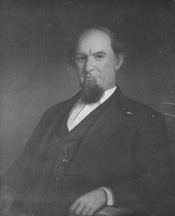Preceded by Zebulon Baird Vance Preceded by Zebulon Baird Vance Education Randolph–Macon College President Grover Cleveland Governor Zebulon Baird Vance Party Democratic Party | Preceded by Thomas A. Osborn Name Thomas Jarvis Lieutenant James L. Robinson Role U.S. senator | |
 | ||
Died June 17, 1915, Greenville, North Carolina, United States Books The papers of Thomas Jordan Jarvis Battles and wars Battle of Drewry's Bluff, American Civil War | ||
Succeeded by Jeter Connelly Pritchard | ||
Thomas Jordan Jarvis (January 18, 1836 – June 17, 1915) was the 44th Governor of the U.S. state of North Carolina from 1879 to 1885. Jarvis later served as a U.S. Senator from 1894 to 1895, and helped establish East Carolina Teachers Training School, now known as East Carolina University, in 1907.
Contents
Early years
Born in Jarvisburg, North Carolina, in Currituck County, he was the son of Elizabeth Daley and Bannister Hardy Jarvis, a Methodist minister and farmer and brother of George, Ann, Margaret, and Elizabeth. His family was of English descent and some of its members highlighted at various points in the history of North Carolina. So, Thomas Jarvis was lieutenant governor of Albemarle during the government of Philip Ludwell, between 1691–97, and General Samuel Jarvis led the militia of Albemarle during his fight in the Revolutionary War. Raised in a poor family, although he had the necessities of life, Jarvis worked when he was young in three hundred acre farm owned by his father, while he was studying about the common schools. Jarvis was educated locally and at nineteen went on to attend Randoph-Macon College, earning an M.A. in 1861. He had to exercise as teacher during the summer to pay for college tuition. An educator by training, Jarvis opened a school in Pasquotank County and would later be one of the founders of East Carolina University.
Career
Jarvis enlisted in the military at the beginning of the American Civil War and served in the Eighth North Carolina Regiment. On April 22, 1863 he was named Captain. Captured and exchanged in 1862, Jarvis, was injured and permanently disabled at the Battle of Drewry's Bluff in 1864. After the war ended, he was on sick leave in Norfolk and in May 1865, he got probation, returning to Jarvisburg.
In 1865, Jarvis returned home and opened a general store before being named a delegate to the 1865 state constitutional convention. In 1867 Jarvis bought to entrepreneur William H. Happer, share of his small general store. More late, after get a license in June of this year, he abandoned the store and moved to Columbia.
Active the Democratic Party, Jarvis was elected to the State House in 1868 and served there for four years, two of them (1870–1872) as Speaker of the House. He exercised a controlling role in the impeachment of Governor William W. Holden, reduced the cost of state government, and investigated railway frauds. In 1872, he was a Democratic elector-at-large on the Horace Greeley ticket. Jarvis also married Mary Woodson in December 1874.
An opponent of federal Reconstruction policy, Jarvis was elected the third lieutenant governor in 1876 on a ticket with Zebulon Vance. In 1879, Vance resigned the governorship to serve in the United States Senate, and Jarvis filled the vacant position. As governor, he fought against government corruption and attempted to cut taxes, the state's debt, and government control. He also completed the sale of various state railways to private companies. He established mental health services in Morganton and Goldsboro, managed the establishment of normal schools for teachers in North Carolina and helped develop the State Board of Health.
He won election in his own right in 1880, defeating Daniel G. Fowle for the Democratic nomination and narrowly winning over Republican challenger Ralph Buxton. In office, Jarvis convinced the legislature to authorize construction of the North Carolina Executive Mansion, although it was not completed until 1891. He "supported establishing a system of county superintendents of education elected by boards of education, grades of teacher certification, standards of examinations for public school teachers, and lists of recommended textbooks. Also, Funds for the mental institutions continued to increase, and the laws of North Carolina were for the first time codified and state insurance laws fully defined. Also, was built a governor's mansion".
Term-limited, Jarvis stepped down as governor in 1885, but was appointed United States Minister to Brazil by President Grover Cleveland. Jarvis held this post for four years, after which he practiced law in Greenville, North Carolina. Following Senator Vance's death in 1894, Jarvis again succeeded him in office, serving as a U.S. Senator through an appointment by Gov. Elias Carr. In 1895, the state legislature, now under the control of Republicans and Populists, would not elect Jarvis to a term of his own.
In 1896, Jarvis was a delegate to the Democratic National Convention, where he supported William Jennings Bryan in his last major political act. He was instrumental in the founding of what is now East Carolina University in Greenville, where the oldest residential hall on campus is named in his memory.
Jarvis reopened his law firm and in 1912, he founded a partnership with Frank Wooten. He died in Greenville in 1915.
Legacy
Personal life
Jarvis married Mary Woodson in December 1874.
